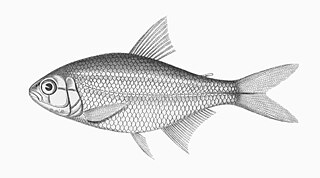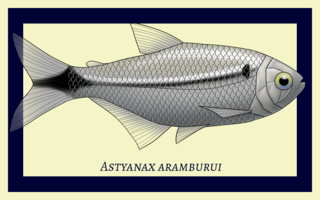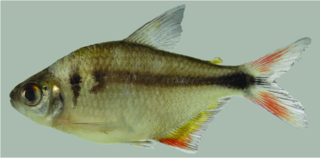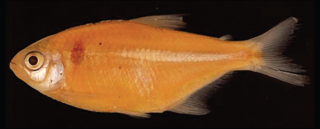
Astyanax is a genus of freshwater fish in the family Characidae of the order Characiformes. Some of these fish, like many of their relatives, are kept as aquarium pets and known collectively as tetras. With around 150 described species and new ones being described yearly, this genus is among the largest of the entire order; Hyphessobrycon also has more than 145 species and which one is larger at any one time depends on whether more species have been recently described in one or the other. The blind and colorless cave tetra of Mexico is a famous member of the genus, but its taxonomic position is disputed: Some recognize it as part of the Mexican tetra and this is supported by phylogenetic evidence, but others recognize the cave form as a separate species, A. jordani.

Astyanax argentatus is a small freshwater fish native to northern Central America and southern North America. Given its native range, it is also known as the Texan tetra. Little has been published regarding the feeding habits or behavior of A. argentatus, but it is known to have the northernmost distribution of any member of the genus Astyanax.

Bryconops tocantinensis is a small freshwater fish from the rivers of Brazil. It has yellow-gold scales on its back and white scales on its belly, with a bright-silver stripe marking the divide between the two. It gets the name "tocantinensis" from its endemism to the upper Tocantins basin drainage - specifically, the Conceição River.

Astyanax abramis is a small freshwater fish from the inland rivers of South America. It is plentiful in almost the entire continent, with a habitat including the La Plata, upper Amazon, and Meta River basins. The body shape is subrhomboidal and laterally compressed, and the scales are largely silver, with a blue or green tint on the dorsal side.

Astyanax altiparanae, sometimes called the yellow-tail tetra or yellow-tail lambari, is a species of schooling freshwater fish widely distributed across the southern half of South America. It is an ecologically flexible species, able to adapt to various resource and space conditions, and its diet follows this pattern; it is considered opportunistic and omnivorous. Its widespread nature and unspecified ecology contribute to its status as a species of least concern on the IUCN Red List. It was originally described from the upper Paraná river basin, which is the origin of its specific epithet; "alto" means "higher" in Brazilian Portuguese, hence "alto Paraná".

Astyanax aramburui is a small freshwater fish from the rivers of South America, restricted to a relatively small region within the Paraná and Uruguay river basins of Argentina. It was named after the scientist who established a professional presence for ichthyology in the country, Raúl Arámburu. Considered a near-threatened species by the IUCN, its range includes creeks in a sub-basin affected by various forms of pollution.

Astyanax argyrimarginatus is a small species of freshwater fish native to various river basins in Brazil. Originally thought to be restricted to the Tocantins-Araguaia river system, a study in 2012 expanded its range to include the Rio Xingu, as well. Specific biotope preferences are unknown, but it is mostly collected from clearwater streams in fairly good health. Its relative abundance and presence in some protected locales means that it is not endangered.

Astyanax asuncionensis is a small species of freshwater fish described in 1972 from Asunción, the capital of Paraguay in South America. Its specific epithet is in reference to this. Currently, its range is known to encompass areas of not just Paraguay but also Argentina and Brazil. It is an adaptable, omnivorous species that easily lives in sympatry with various congeners.

Astyanax bagual is a small species of freshwater fish known only from the Taquari-Antas river basin in southern Brazil. It is unusual in the genus Astyanax because mature male specimens display bony hooks on the rays of all fins; in opposition, most others have them on the anal, pelvic, or pectoral fins - sometimes on more than one of these, but very rarely on all fins. It can further be told apart from various congeners by way of dentition and some aspects of coloration, including the presence of two humeral spots instead of one.

The twospot astyanax, also called the two-spot tetra, is a small species of freshwater fish native to South America. It is a middlingly common tetra in the aquarium industry, with hobbyist reports of its sale and presence, and it is also a well-studied member of the genus Astyanax in wild settings. Amateur aquarists report peaceful schooling behavior in captivity, though fish in wild schools may turn on one another if presented with the threat of a predatory species.

Astyanax bourgeti is a small species of freshwater fish native to the upper Amazon river in Brazil. Originally described in 1908, it is not a particularly well-studied member of the genus Astyanax, but there is enough information available to establish a native range, an appearance, and potential relationships to congeners; for example, A. bourgeti is a known member of the subgenus Poecilurichthys, and has been considered such for most of its existence. Biotope preferences, sympatry, diet, and behavior are all unknown.

Astyanax brachypterygium is a small species of freshwater fish endemic to a collection of high-elevation streams in Brazil. It was named in 2001 alongside congener Astyanax cremnobates, to which it bears a strong resemblance; physical details help to differentiate between the two. Its scales are a greenish-brown on the back and silver on the belly, with reddish fins and a dark humeral spot. One of its defining features is a notably short anal-fin base, which has 13 to 15 rays.

Astyanax brevirhinus is a small species of freshwater fish known only from a river basin in northeastern Brazil. It is somewhat understudied and lacks a conservation status, but it is present in a region that is the subject of an ecological restoration project - the Jequitinhonha River. Specifics of diet and behavior are unknown, though shoaling activity has been observed in laboratory conditions.
Astyanax apiaka is a small freshwater fish endemic to the Apiacá river in Mato Grosso, Brazil. Its discovery is recent, as of 2023, which results in little published research of its natural behaviors or preferred biotopes. However, descriptions of its appearance and general environment have been solidified, as well as some baseline information regarding its diet. It lacks a conservation status from the IUCN.

Astyanax chaparae, sometimes called the Chapare tetra, is a small species of freshwater fish only found in Bolivia. It is endemic to its type locality, the Río Chapare, which is a tributary of the Mamoré located in the Cochabamba department. Little else is known of its diet, behavior, and ecology. Its conservation status is similarly unclear, as the IUCN ranks it a data deficient species.

Astyanax clavitaeniatus is a small species of freshwater fish native to various rivers in the Amazon basin. It is characterized by a club-shaped lateral stripe, which is where it gets its scientific name; "clava" means "club", and "taenia" means "stripe". It is a deep-bodied fish with a silvery base color, which is not uncommon for members of Astyanax. Its markings - including a humeral spot and two vertical brown bars - indicate that it is a part of a species complex centered around congener Astyanax bimaculatus.

Deuterodon heterostomus is a small species of characin endemic to a large river system in southeast Brazil. It was originally the only member of the genus Probolodus, but Probolodus is now considered obsolete, synonymized with Deuterodon. Much like other members of Deuterodon, and like some fish in related genera, D. heterostomus is a small, silvery fish with fins in some combination of red and clear. It has a defined humeral spot that can be used for identification.

Deuterodon oyakawai is a small species of characin endemic to a large river basin along the Atlantic coast in southeast Brazil. It was originally one of three members of the genus Probolodus, but Probolodus is now considered obsolete, synonymized with Deuterodon. Much like other members of Deuterodon, and like some species in related genera, D. oyakawai is a small, silvery fish with fins in some combination of red and clear. It has a defined humeral spot that can be used for identification.

Deuterodon sazimai is a small freshwater fish endemic to a handful of river basins in southeastern Brazil. Upon being first described, it was considered a member of genus Probolodus; Probolodus is now considered obsolete, synonymized with Deuterodon. Much like other members of Deuterodon, and like some species in related genera like Astyanax or Jupiaba, D. oyakawai is a silvery fish with fins in some combination of red and clear. It sports a wedge-shaped humeral spot, and an oval-shaped blotch on its tail joint.
Astyanax anai is a small freshwater fish native to Central America. It has a restricted range, inhabiting a handful of Atlantic drainages in Costa Rica and Panama, and is known from locales only up to 100 meters elevation. As an endangered species, A. anai is a point of interest for conservation biologists studying the region. It can be found living sympatrically with other species of Astyanax, but is less common than its relatives.



















